The purpose of this page is to discuss the role and function of the enzyme phenylalanine hydroxylase, which is encoded by the PAH gene in humans.
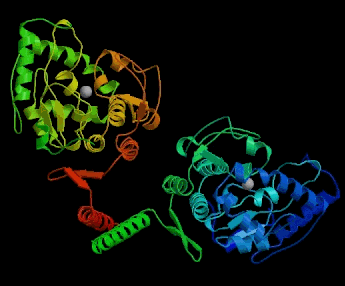
Figure 1. Three-dimensional structure of phenylalanine hydroxylase enyzme. (Image courtesy of Protein Databank. ID: 2PAH; PDB, 2003).
.Genetic Information:

Figure 2. Ideogram of chromosome 12 depicting approximate location of PAH on the long portion. PAH's location is denoted by red marker (Image courtesy NCBI's Map Viewer (NCBI, 2003).
The gene for PAH is located on chromosome 12 in humans. It is 79, 277 bases long. Click here to see the mRNA sequence (2680 bases long). According to LocusLink, its cytogenetic address is 12q22-q24.2, on the long arm of the chromosome (Figure 2). PAH has a number of known orthologs in other organisms, one of the most important of which is found in mice. Figure 3 is a screen capture of a list of organisms with sequences that are highly conserved. One can see that a number of the items shown in the list are self-matches between different entries for the Homo sapien PAH gene. However, towards the bottom of the list there are entries for Rattus norvegicus and Mus musculus. The mouse is an important model organism for the study of PAH and its role in metabolism, due to the great amount of conservation between the human and mouse PAH genes. To emphasize this similarity, Figure 4 shows the results of a BLAST2 alignment between human and mouse PAH (NCBI's BLAST and BLAST2, 2003). There are also PAH orthologs in Drosophila melanogaster, Sus scrofa, Gorilla gorilla graueri, and Caenorhabditis elegans (NCBI's BLAST and GeneCards, 2003).
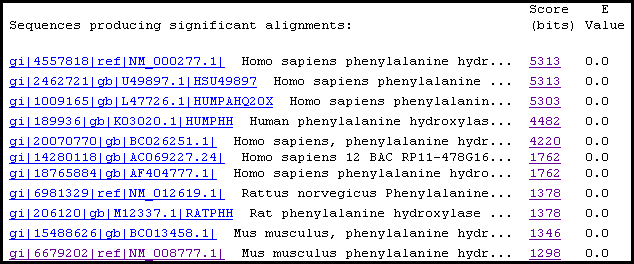
Figure 3. Results of a BLAST search using the sequence for human PAH (accession number: NM_000277). The first seven entries are self-matches with multiple NCBI entries for PAH. The last four entries show that the PAH sequences among humans, rats, and mice are highly conserved. The amount of similarity is shown as an E value. As the E value becomes closer to zero, the amount of similarity between sequences increases (NCBI's BLAST, 2003).
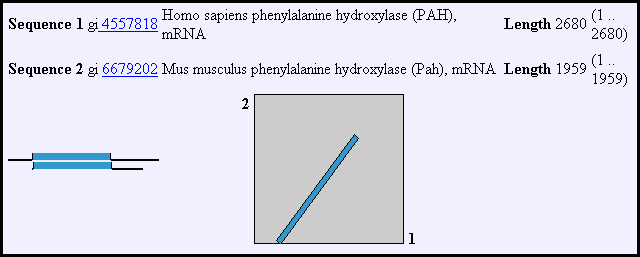
Figure 4. Results of an alignment between human and mouse PAH sequences. The line is unbroken and travels fairly evenly from the bottom left corner to the top right corner, meaning that the sequences are highly conserved. A perfect alignment travels directly from bottom left to top right, dividing the grey square into exact halves (NCBI's BLAST2, 2003).
Protein information:
PAH encodes for the enyzme phenylalanine hydroxylase. This protein's sequence contains 452 amino acids. It is primarily expressed in the liver. However, phenylalanine hydroxylase is also expressed in the kidney and spleen (GeneCards, 2003). The phenylanine hydroxylase enzyme can exist as several different isozymes, which are dimers, tetramers, or longer polymers of the same repeating subunit. Each chain folds to form three domains: an N-terminal regulatory domain, a catalytic domain, and a C-terminal oligomerization domain (Miranda, et al., 2002). Figure 5 is a Chime plug-in depicting human phenylalanine hydroxylase. Using the following buttons, you can alter the view of this protein. Click here to rotate the enzyme. Figure 5 consists of 2 chains. Click here to highlight the individual chains. Click here to highlight the catalytic domain (residues 118-427). Click here to highlight the C terminus (residues 428-452).
Figure 5. Three-dimensional fragment of phenylalanine hydroxylase (residues 118-452) (Image courtesy of Protein Databank. ID: 2PAH; PDB, 2003). Requires Chime plug-in.
Phenylalanine Hydroxylase and Amino Acid Metabolism:
When proteins are introduced to the stomach, they are denatured by its acidity (pH 1.0-2.5). With the peptide bonds now more accessible to cleavage, enzymes are secreted which hydrolyze peptide bonds, breaking the proteins into smaller peptides. When these pass into the small intestine, further peptidases break the peptides down into their component amino acids. The amino acids are absorbed by the intestinal mucosa, enter the capillaries, and finally, travel to the liver for processing . Phenylalanine is an essential amino acid (the body is unable to synthesize it). Once it enters the liver, it is converted to tyrosine by phenylalanine hydroxylase (Figure 6). In fact, phenylalanine hydroxylase represents the first and rate-limiting step in the catalysis of phenylalanine catabolism. Via its conversion to tyrosine, phenylalanine is a precursor to acetyl-coenzyme A, dopamine, norepinephrine, epinephrine, and melanin . The reaction which catalyzes the conversion of phenylalanine to tyrosine involves oxidation of NADH to form NAD+ and the reduction of O2 to form H20. It is also dependent on the conversion of tetrahydrobiopterin into dihydrobiopterin, a reaction which serves to carry the electrons from NADH to O2 (Nelson and Cox, 2000). The newly formed tyrosine is then fed into pathways for tyrosine metabolism, alkaloid biosynthesis, and puromycin biosynthesis (Figure 7; GenomeNet, 2003). One product of tyrosine metabolism, acetyl-CoA, is an important player in oxidative phosphorylation and a number of other biochemical processes.
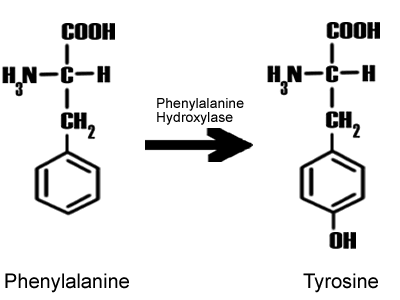
Figure 6. The conversion of L-phenylalanine to L-tyrosine by phenylalanine hydroxylase. The overall reaction is L-phenylalanine + tetrahydrobiopterin + O2 + NADH(H+) yields L-tyrosine + dihydrobiopterin + H20 + NAD+ (Nelson and Cox, 2000). Figure by John Kogoy.
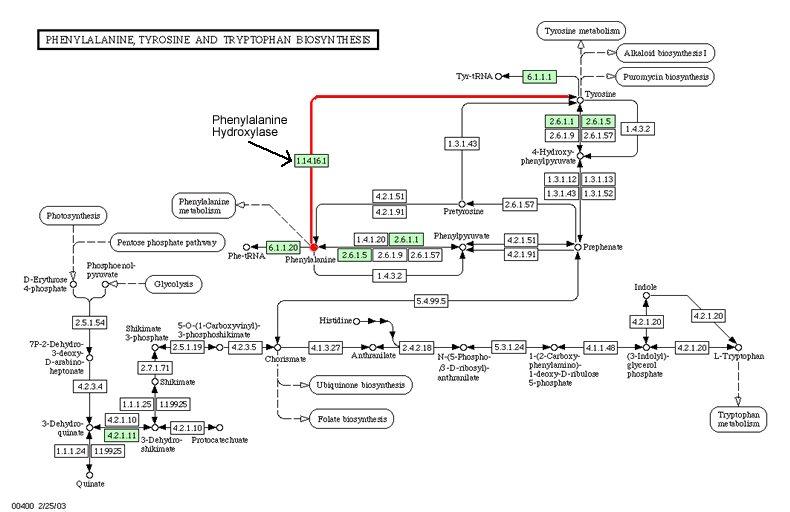
Figure 7. Biosynthetic pathways of phenylalanine, tyrosine, and tryptophan. Phenylalanine's path to tyrosine metabolism has been highlighted in red. (Image courtesy of GenomeNet, 2003, modified by John M. Kogoy).
Known Mutations and Phenylketonuria:
A deficiency of functioning phenylalanine hydroxylase results in the condition phenylketonuria (PKU). As of 2001, there were greater than 400 different mutations known to cause phenylketonuria. Studies have shown that phenylalanine hydroxylase is slightly unstable, even in its wild type form. This is one explanation for the fact that it has a large number of mutants which are unstable and function improperly (Gjetting, et al., 2001). The severity of the illness varies, depending on the location and nature of the mutation, which include nonsense, missense, and splicing mutations. Missense mutations account for over sixty percent of cases of PKU. Mutations in PAH are usually deleterious, because they result in aggregation and degradation of the protein product (Gjetting, et al., 2001). Mutations can result in a milder form of PKU called hyperphenylalanemia.
PKU is inherited in an autosomal recessive manner. One interesting feature of PKU's inheritence is that when a person is heterozygous for two deleterious mutations of PAH, their phenotype will correspond to the milder of the two mutations (NCBI, 2003). PKU is the most common genetic amino acid metabolism disorder in whites (Gjetting et al., 2001). Since the normal pathway is non-functioning in PKU, some of the phenylalanine is processed in another, less-used pathway, becoming converted into phenylpyruvate. Both phenylalanine and phenylpyruvate accumulate in the blood and must be excreted through urination (Nelson and Cox, 2000).
If PKU goes undiagnosed in infants, it can lead to mental retardation, organ damage, and peculiar posture (NCBI, 2003). In infants, the accumulation of phenylalanine is toxic, as it has severe effects on the development of the brain. Therefore, by taking a strict diet which excludes phenylalanine, many of the complications of PKU can be avoided. In adults, phenylalanine accumulation is not nearly as harmful. In mothers who are homozygous for PKU, unless the strict no-phenylalanine diet is followed, severe complications can arise in the development of the child. Children of mothers with PKU have been found to express phenotypes of cardiac malformation, craniofacial abnormalities, microcephaly, and retardation of growth (OMIM, 2003). Diagnosis of PKU used to depend on detection of the abnormal urine smell that accompanies phenylacetate (a by-product of phenylpyruvate metabolism), however, PKU can now be detected with RFLP analysis (OMIM, 2003).
Deficiency of functioning phenylalanine hydroxylase is not the only cause of PKU. Since the conversion of phenylalanine to tyrosine depends on the oxidation of tetrahydrobiopterin, PKU can also be caused by mutations in the gene for dihydrobiopterin reductase, the enzyme which catalyzes the regeneration of tetrahydrobiopterin (Nelson and Cox, 2003).
References:
Gjetting, Torben, et al. "Missense Mutations in the N-Terminal Domain of Human Phenylalanine Hydroxylase Interfere with Binding of Regulatory Phenylalanine." The American Journal of Human Genetics. 68:1353-1360, 2001.
Miranda, Frederico, et al. "Phosphorylation and Mutations of Ser16 in Human Phenylalanine Hydroxylase." The Journal of Biological Chemistry. 277: 40937-40943, 2002.
NCBI's BLAST and BLAST2. National Center for Biotechnology Information. Accessed March 14, 2003. <http://www.ncbi.nlm.nih.gov/BLAST/> and <http://www.ncbi.nlm.nih.gov/blast/bl2seq/bl2.html>
NCBI's Map Viewer. National Center for Biotechnology Information. Accessed March 12, 2003. <http://www.ncbi.nlm.nih.gov/mapview/maps.cgi?ORG=hum&chr=12&maps=cntg-r,clone,scan,ugHs,loc&VERBOSE=ON&cmd=focus&fill=40&size-40&query=PAH>
Nelson, David, and Michael Cox. Lehninger Principles of Biochemistry, 3rd Edition. New York: Worth, 2000. pp. 637-655.
"PAH." GeneCards Database. Accessed March 12, 2003. <http://genome-www.stanford.edu/cgi-bin/genecards/carddisp?PAH&search=PAH&suff=txt>
"Phenylalanine, Tyrosine, and Tryptophan Biosynthesis." GenomeNet. Accessed March 13, 2003. <http://www.genome.ad.jp/dbget-bin/get_pathway?org_name=hsa&mapno=00400>
"Phenylketonuria." Genes and Disease. National Center for Biotechnology Information. Accessed March 12, 2003. <http://www.ncbi.nlm.nih.gov/books/bv.fcgi?call=bv.View..ShowSection&rid=gnd>
"Phenylketonuria." Online Mendelian Inheritence in Man. National Center for Biotechnology Information. Accessed March 14, 2003. <http://www.ncbi.nlm.nih.gov/entrez/dispomim.cgi?id=261600>
"2PAH." Brookhaven Protein Databank. Accessed March 14, 2003. <http://www.rcsb.org/pdb/cgi/explore.cgi?pid=279691047653427&pdbId=2PAH>